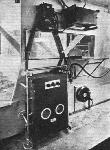Caproni Са 97
Caproni Са 97, созданный в 1927 году, оснащался тремя звездообразными двигателями Lorraine-Dietrich мощностью 130 л. с. (97 кВт). Это был моноплан с высокорасположенным крылом, который мог перевозить шесть пассажиров. Также выпускались варианты с одним или двумя двигателями мощностью 400-500 л. с. (298-373 кВт). Самолет использовался как транспортный, учебный, санитарный, а также в качестве бомбардировщика и разведчика. Строился и гидроплан Са 97 Idro с силовой установкой на базе двигателя Jupiter и оснащенный двумя поплавками. Было выпущено 13 самолетов Са 97.
ТАКТИКО-ТЕХНИЧЕСКИЕ ХАРАКТЕРИСТИКИ
Caproni Са 97
Тип: самолет общего назначения
Силовая установка: звездообразный двигатель Bristol Jupiter мощностью 500 л. с. (373 кВт)
Летные характеристики: максимальная скорость на оптимальной высоте 225 км/ч; практический потолок 7400 м; дальность полета 1000 км
Масса: пустого 1500 кг; максимальная взлетная 2495 кг
Размеры: размах крыла 15,95 м; длина 10,70 м; высота 3,35 м; площадь крыла 40,00 м2
Вооружение: один наводимый пулемет Lewis или Breda-SAFAT калибра 7,7 мм в надфюзеляжной установке
Полезная нагрузка: до шести пассажиров
Показать полностьюShow all
Flight, August 1929
THE CAPRONI "C.A. 97" COLONIAL
AN ITALIAN ALL-METAL MACHINE FOR MILITARY SERVICE
ONE of the recent productions of the well-known Italian firm of Caproni is the "Ca 97 Colonial," some brief particulars of which we are able to give below. This machine, which is of all-metal construction, is intended for Colonial work, and the various requirements for military and colonial service have been combined in its design and embodied in the one machine. For example, it is suitable for troop-carrying - for conveying reinforcements, at a moment's notice, to distant forces, or relieving them - whilst at the same time it can also be employed as a useful offensive machine, for the protection of marching troops, reconnaissance, patrol work, scouting, bombing, etc.
An equally important use to which it can be put is the transport of food, water, munitions, and other urgent materials; and finally, for the transport of sick and wounded. For colonial work, therefore, it will be seen that this machine should serve a useful purpose indeed.
For troop carrying it can carry 10 armed soldiers - a small number, perhaps, individually, but with a fleet of machines, possibly making several return journeys from the base, which could easily be accomplished owing to its high speed, would not be such an unimportant number all told, especially for colonial expeditions or actions.
As regards food transport, etc., the Caproni "Colonial" is able to carry 600 kgs. (1,320 lbs.) of useful load in addition to pilot, crew, and fuel. For ambulance work it can carry one seriously wounded "case" on a stretcher, two slightly wounded, one doctor, and an assistant or nurse; or six slightly wounded, doctor, and nurse. In this sphere of activity we need not dwell further on the advantages offered, for it has been proved in many cases, in all parts of the world, that the aeroplane can provide most valuable service - and this is particularly so in colonial countries where distances are great and and transport is unsafe or dangerous.
As an offensive weapon provision has been made for the equipment of two machine guns and a load of 250 kg. (551 lbs.) of small bombs, the installation and operation, etc. of which have been carefully considered in the design.
Turning now to the machine itself, the Caproni "Colonial" is a high-wing monoplane of the "semi-cantilever" type with the fuselage carried up to the wing, the pilot being located forward and protected by a windscreen extending up from the fuselage to the leading edge of the wing. Troops, gunners, sick, or cargo are carried in a large cabin, beneath the wings, in the fuselage.
The wings are braced by a system of struts, one main set extending from the lower fuselage longerons to the wing spars, and another set from the top of the fuselage to a point nearly midway on the main struts, where the landing gear absorber struts are attached. The wings are set at a slight dihedral, but have no sweep-back, and the fuel tanks are located in the wings. An adjustable tail-plane is fitted.
A very wide track landing gear is provided, this being of the non-axle type, the wheels being carried by V-members from the lower longerons of the fuselage, and the absorbers by vertical members extending up to wing struts. We understand that brakes are also fitted.
Normally, the "Caproni Colonial" is powered with a single 400-h.p. engine (or 450-h.p. "Jupiter") in the nose of the fuselage, but a noteworthy feature of this machine is that it can, if required, be equipped with three 130-150 h.p. engines, by mounting the two extra engines beneath the wings, on the bracing struts - at the junction of the two sets referred to above. Also, it may be converted into a twin-engined job by fitting two 200 h.p. engines (such as the Armstrong Siddeley "Lynx") on the wings only.
This multi-engine feature is illustrated by Ca. 97 Commercial six-passenger machine, which is similar in most respects to the "Colonial," and which is employed on the Rome-Milan-Monaco air line.
The principal characteristics of the Caproni "Colonial” are :-
Span 52 ft. 6 in. (15-970 m.).
Overall length 35 ft. (10-710 m.).
Height 7 ft. 8 in. (3-350 m.).
Wing area 430-4 sq. ft. (40 sq. m.).
Wheel track 16 ft. 4 in. (4-040 m.).
Weight empty 2,646 lb. (1,200 kg.).
Useful load 2,205 lb. (1,000 kg.).
Total weight 4,851 lb. (2,20) kg.)
Speed range 56-119 m.p.h. (90-192 k.p.h.)
Endurance Five hours.
Note.- The dimensions of the "Commercial” type are, with one or two exceptions, the same.
Показать полностьюShow all








